30: The Not-So-Minor Cardmakers of the 19th Century - Gibson, Hunt & Bancks
A preliminary look at the card-makers operating in the 19th century.

Mike Goodall's series of booklets on 19th century cardmakers has the wrong name: the makers are by no means all minor. It gives the impression that only Goodall and De La Rue were major players in what was at that time a changing industry. It's true that those two firms were the only two to survive into the 20th century (with the exception of Woolley and James English, who finished about 1904, and Reynolds, which was owned by Goodall anyway), but that has no particular significance in the developmental history of playing cards.
For a timeline presentation of English card-makers 1761-1905, see page 20►
If we look at the figures of card production from 1824 (presented by Lawrence Alt in an IPCS Journal article from the 1826 report of the Commission of Enquiry into various kinds of taxation, including playing cards), we can see clearly who the big players were at the time. The following are the official figures for the major makers, first the number of packs for the home market and second that for exportation.
Maker Home : Export
CRESWICK 39,160 : 16,844
HALL 37,500 : 31,410
HARDY 17,540 : 32,736
HUNT 97,000 : 20,684
None of the other makers, including the emerging Goodall, produced more than 5,500 packs in that year, either home or export, while Fuller produced only 144, just for the home market.
In the jurors' report of the Great Exhibition of 1851 the number of packs produced by all makers in 1850 is given as 235,650 (home) and 329,888 (export), though the De La Rue archives referred to below give the export figure for 1850 as 377,306. For 1851 the numbers given are 226,576 (home) and 281,106 (export), a reduction in both categories. Going forward a few years, the picture has changed a little since 1850, but a lot since 1824. The figures come from a hand-written document found in the De La Rue archives by Mike Goodall and reproduced in his booklet British Playing Card Manufacture in the 19th Century. Some of the makers from the 1820s have disappeared and others have grown in size; De La Rue has been going for 23 years. Using the same format as above, the figures for home and export markets are given in pack numbers. I've also given a percentage of the overall output in each category. For each maker the figures cover the years 1855-60.
Maker/Date Home : Export
BANCKS 1855 42,200 (17.7%) : 7,795 (3.1%) (successors to HALL & HUNT)
1856 41,500 (14.1%) : 6,000 (1.7%)
1857 37,200 (13.4%) : 2,832 (0.5%)
1858 33,600 (11.3%) : 3,792 (1.0%)
1859 33,100 (10.6%) : 2,400 (0.6%)
1860 28,700 (9.7%) : No figure given
DE LA RUE 1855 69,400 (29.2%) : 54,966 (21.9%)
1856 93,060 (31.7%) : 90,662 (26.1%)
1857 93,000 (33.6%) : 183,392 (38.8%)
1858 108,150 (36.3%) : 122,718 (32.4%)
1859 120,700 (38.5%) : 131,634 (33.3%)
1860 117,300 (39.9%) : 110,584 (36.0%)
GOODALL 1855 47,736 (20.1%) : 36,178 (14.4%)
1856 50,500 (17.2%) : 78,036 (22.4%)
1857 55,000 (19.9%) : 82,950 (17.6%)
1858 58,800 (19.8%) : 48,226 (12.7%)
1859 65,450 (20.9%) : 49,603 (12.5%)
1860 68,000 (23.1%) : 34,398 (11.2%)
REYNOLDS 1855 60,901 (25.6%) : 90,372 (36.0%)
1856 72,860 (24.8%) : 121,968 (35.1%)
1857 71,261 (25.7%) : 175,604 (37.2%)
1858 68,020 (22.9%) : 178,958 (47.2%)
1859 70,882 (22.6%) : 196,374 (49.7%)
1860 64,576 (22.0%) : 152,928 (49.8%)
The other makers are small in comparison, though Whitaker has a reasonable export trade in 1855 (17%), but this dwindles over the six years in question to 2.8% by 1859 & 1860. The firm seems to have ceased in 1861 or 1862. It is clear from these figures that De La Rue is the biggest mover in the home market. He also gets an increasing share of the export trade, but not as much as Reynolds. Clearly, both Goodall and Reynolds have expanded tremendously in the 30 years since 1824, where they hardly featured at all. Bancks, on the other hand, is on the wane. When you compare the combined figures of Hall (& Bancks) and Hunt from the 1820s, the antecedents of Bancks, with those of the 1850s, the decline is very striking. Even between 1855 and 1860 the decline is obvious. Maybe the Bancks brothers had little interest in the playing card business they inherited. Production methods, which were static, and a lack of interest in developing back designs as a focus of marketing all suggest a lack of interest in development. Even though Reynolds' production methods were not as advanced as those of De La Rue and certainly the later Goodall, they at least introduced a range of decorative back designs and surfaces for improving play. Nevertheless, by the end of the 1870s both Bancks and Reynolds were well on the way out. Neither firm introduced round corners or corner indices; indexed cards by Reynolds & Co were manufactured by Goodall. After the end of the Old Frizzle period new makers, such as Willis, James English and a revived Woolley, came into the market, and their more up-to-date production methods also no doubt helped to put paid to the two other ailing companies. In 1860 the De La Rue archives give the total output as 294,000 (home) and 307,006 (export), but the reduction of the tax from 1/- to 3d gave a remarkable boost to output. However, the increase in output did not produce an increase in revenue for the Government, at least not immediately. In the last year of the shilling tax (1861-62) the home output was 272,300 packs, producing a revenue of £13,615, but in 1862-63 the home output increased substantially to 732,960, producing only £9,162, and in 1863-64 home output was 656,020 packs, producing only £8,200/5/-. The 1860s saw only a slow increase in revenue, while the overall production figures continued to grow. In 1866 De La Rue alone produced 299,468 packs. I don't have figures for the other makers. (It's interesting to compare these Victorian figures with the number of imported packs a hundred years later in 1966: 322,559 dozen packs!) In 1868 the overall output for the home market was 734,040 packs, but the income was only £9,213, well below the income generated by the old shilling tax. Further figures for subsequent years are given by Mike Goodall in his book on The Firm & the Family in Appendix VI: the problem with Mike's figures is that up until 1862 the tax on dice was included in the figures sent to him in 1979 by the Office of the Controller of Stamps. In the 1826 report referred to above the duty and number of packs are given from 1801-25; the only overlapping years are 1819 and 1820, which show cards produced some £3,000 less than the total including dice. Rather than 206,984 packs in 1819, the figure should be179,561; for 1820 the figure should be 170,138 packs, not 192,680. From 1862 onwards the figures should be correct: the annual income is multiplied by 240 to give the figure in pence and then divided by 3 to give the number of packs.
However, different sources give somewhat different figures for some of the years. For example, in The Westminster Papers (March 1871) revised their own figures from March 1869 because of an oddity in the tax system whereby makers paid 3s/9d on a dozen packs, an increase of 9d on twelve individual packs. So they give the following production figures:
1868: 748,324 packs
1869: 825,948 packs
1870: 984,210 packs.
The last of these produced £12,303, getting back close to the levels of the one shilling tax. In the 1872 Kelly's Post Office Directory the number of packs produced in 1871 is given: 37,294 dozen packs (447,528 home) and 35,004 dozen packs (420,048 export). These figures seem to be at odds with the previous years, where the figures are supposed to be for the home market alone. A later source gives the following figures:
1875: 1,104,873 packs
1883: 1,219,617 packs
1884: 1,204,560 packs.
When you look at these figures, it is not surprising that so many of the cards of the major makers have survived. At different periods different makers were in the ascendant or on the decline; some really were minor producers. In general terms, however, we can give an idea of what should be considered the major manufacturers in England at different periods throughout the 19th century. Going further back into the 18th century, some of the major makers started then, even though they may have been taken over and changed their name. One of the biggest, Hunt, started with Blanchard, whose firm was taken over by Gibson in 1769 (and ran it with and without Gisborne); Hunt joined the firm as a partner in 1801, then took over in 1804. Hall took over the business of Llewellyn, probably the successor to McEvoy, in 1785; by 1820 it had been inherited by son and son-in-law, Hall & Bancks, who were in turn uncle and father of the Bancks brothers. By 1840 the firms of Hunt and Hall & Bancks had amalgamated, though probably produced cards under both names until the end of the decade. In 1849 the first Bancks Brothers Old Frizzle was produced and took over from the other two names. So, in the early part of the 19th century we can say that the major makers were: Hunt, Hall (& Bancks), Hardy and Creswick (from 1820). By the 1850s, as we have already seen, the front-runners had changed: De La Rue, Reynolds and Goodall, with a declining Bancks. After 1862 Goodall makes enormous strides into the market and it and De La Rue are the clear leaders until the end of the century, by which time they are virtually the only remaining makers
To start with, a couple of fairly early examples: McEvoy seems to have been taken over by Llewellyn, who in his turn was taken over by Hall. The outlines of these courts are in black, whereas in later packs blue became the norm.

The above pack is a very early Gibson pack with characteristics that eventually disappeared from the design, e.g. the sleeve beyond the edge of the design on the JS and the jutting-out jaw of the KC. Gibson, however, was to become a major maker of the late 18th century. I start with an early example from the Coming Museum collection.
For a list of the examples in my collection of the cards produced by Blanchard, Gibson, Hunt and Bancks Brothers, click here►
GIBSON


Above two images: an early Gibson & Co pack (from the Cuming Museum)
 Gibson & Gisborne Type I, AS A3 (109, 1st repair), Gibson & Co. Henry VIII wrapper, c.1795
Gibson & Gisborne Type I, AS A3 (109, 1st repair), Gibson & Co. Henry VIII wrapper, c.1795
 Gibson & Gisborne early Type I, AS A1 (30). c.1774
Gibson & Gisborne early Type I, AS A1 (30). c.1774
The later Gibson packs were sometimes like those of Hall, but he produced more of the type adopted later by Hunt after the merger.

Gibson Type II, AS A3 (147), c.1790; note the QH's tulip and the extra red colour on the JC, bottom right
HUNT

Above: an early Hunt pack with Blanchard courts, presumably old stock from the original maker (from the Victoria & Albert Museum).
Hunt also used courts of the Hall type in the early years of his independent operation.

Above: early Hunt, c.1797; note the QH's tulip and extra red on the JC, as in the Gibson pack above.

Another early pack, but with the more usual later courts by Hunt, c.1795, from Sylvia Mann's collection. Note that the KH is of the Hall type; as the outline is black rather than blue, it is probably not original.

A Hunt pack with 'Exportation' scratched off the AS (a tax dodge) and the JC made from a spare JH, no doubt a second-hand pack.
Hunt was one of the first makers to redraw their courts and update the images around 1820.

HB5 is an unusual version of standard courts, also found with Stopforth ASs.
Hunt seems to have developed further the idea of smaller cards, as those above, which most other makers only produced in piquet cards. They also produced smaller cards with full-size courts of a traditional kind (HB3).

For later examples of Hunt packs with the redrawn courts, such as those below, see the Plainbacks website and my contribution to it.

HB1 large noses on queens; small noses on queens; HB1.1
Although HB1.1 is common in packs by Bancks, there is a pack on the Plainbacks website with these courts and a Hunt Old Frizzle, which suggests that the first versions of their double-headed cards appeared around 1850. How long it took to use up all the many Hunt Old Frizzles is anybody's guess, but the first Bancks Frizzle was issued in 1849.

By Ken Lodge
Member since May 14, 2012
I'm Ken Lodge and have been collecting playing cards since I was about eighteen months old (1945). I am also a trained academic, so I can observe and analyze reasonably well. I've applied these analytical techniques over a long period of time to the study of playing cards and have managed to assemble a large amount of information about them, especially those of the standard English pattern. About Ken Lodge →
Trending Articles
Popular articles from the past 28 days
Related Articles
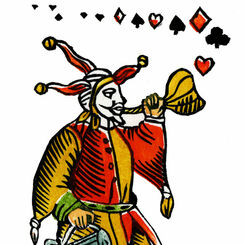
Woodblock and Stencil Joker
A limited edition art print of the 1984 woodblock joker.
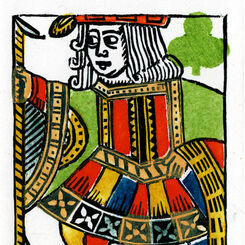
Woodblock and Stencil Jack of Clubs
A limited edition art print of the Jack of Clubs 1984 woodblock joker.
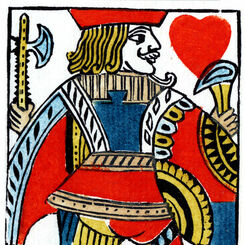
Woodblock and Stencil Jack of Hearts
A limited edition art print of the Jack of Hearts 1984 woodblock joker.
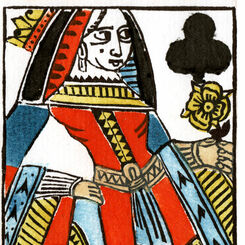
Woodblock and Stencil Queen of Clubs
A limited edition art print of the Queen of Clubs 1984 woodblock joker.
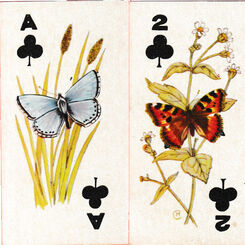
Sweetule Natural History cards
Small cards featuring natural history subjects, given away with packets of sweet cigarettes.
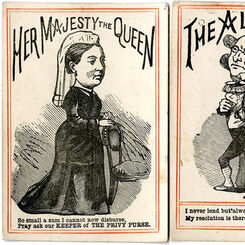
Lend Me Five Shillings
or “Her Majesty’s Privy Purse” - a merry round-the-table game published by D. Ogilvy.
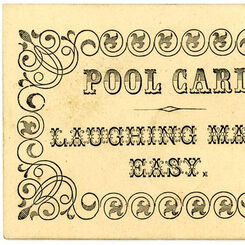
Laughing Made Easy
a Victorian card game published by D. Ogilvy.
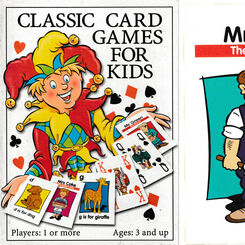
Classic Card Games for Kids
A boxed set of playing cards, Happy Families and an alphabet pack with rules for 22 games.
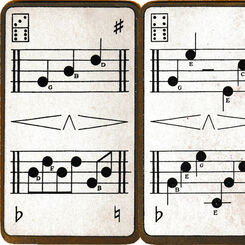
So-Lah – A Game of Music
An early 20th century domino-type musical card game by Goodall.
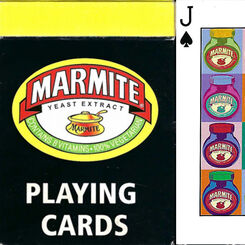
Marmite
Fifty-Four images celebrating a UK savoury spread, that has been around one hundred and twenty two y...
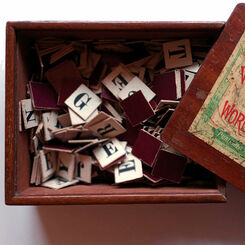
Word Making and Word Taking
How crossword and spelling games became popular.
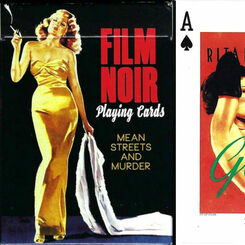
Film Noir
A deck of 55 cards, celebrating hard boiled heroes, wise-cracking women, mean streets, guns and gums...
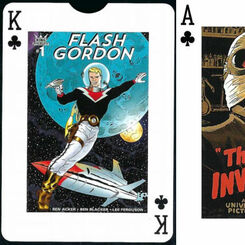
Science Fiction
A deck of 55 cards, celebrating a time when Science Fiction truly was, Science Fiction.
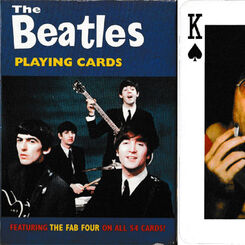
The Beatles playing cards
Two packs featuring photos of The Beatles issued by the same publisher in 2004 and 2005.
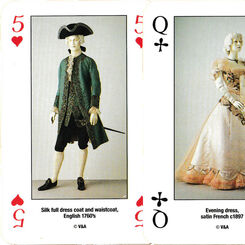
Costume Playing Cards
Four centuries of costumes from the Costume Court at the Victoria and Albert Museum.
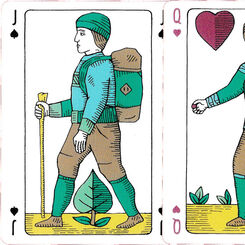
Commoners playing cards
Created by Ian Cumpstey dedicated to the common land and the countryside.
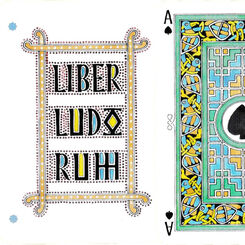
Liber Ludorum
Liber Ludorum playing cards created by Ian Cumpstey in the insular style, United Kingdom, 2019.
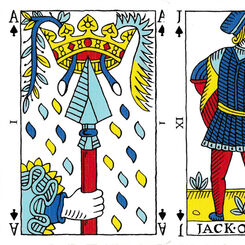
Pike and Clover playing cards
Pike and Clover playing cards created by Ian Cumpstey, Cumbria, UK, 2018.
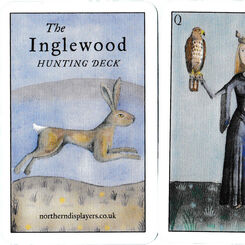
Inglewood Hunting Deck
Inglewood Hunting Deck created by Ian Cumpstey, United Kingdom, 2023.
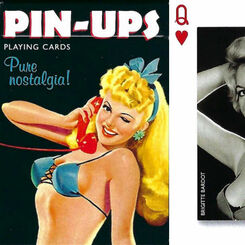
Pin-Ups
A deck of 55 cards celebrating a golden age of cheeky, naughty, bold and curvy ladies in film.
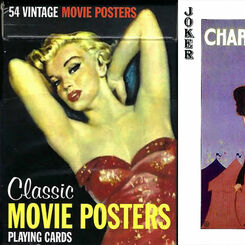
Classic Movie Posters
A deck of 55 cards presenting vintage classic movies and their stars.
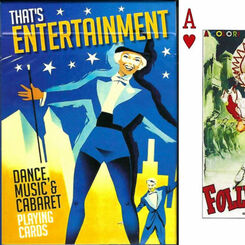
That’s Entertainment
A deck of 55 cards celebrating 20th Century vaudeville, musicals and cabaret.
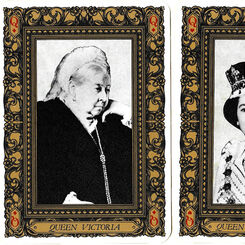
British Monarchs
Commemorating the royal wedding of Charles, Prince of Wales to Lady Diana Spencer on the 29th
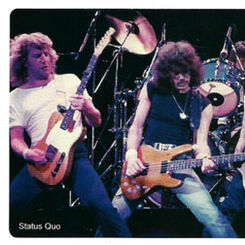
Rock & Pop Legends
Stunning photos of a selection of US and UK music artists.
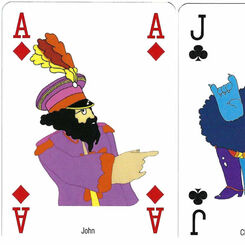
The Beatles • Yellow Submarine
A colourful deck celebrating the 1968 animated feature film based on the Lennon/McCartney song of th...
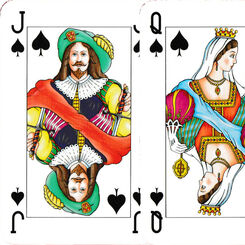
Dutch Court playing cards
Games & Print Services’ version of the Dutch pattern.
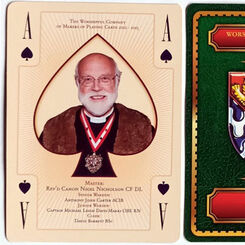
Past Masters’ Association Presentation Pack
The Worshipful Company of Makers of Playing Cards Past Masters’ Association Presentation Pack, 2013....
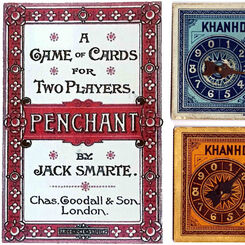
The Search for New Games in the late 19th century
A few new games survived and are still around today; most came and went and are only witnessed in th...
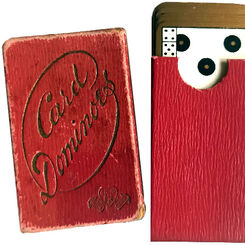
Miniature Card Dominoes
A miniature set of Goodall domino cards (5.9 x 3.5 cms) still in perfect condition.
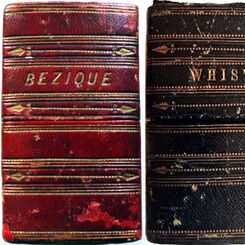
T. Drayton & Son
Bezique and Whist boxed sets by T. Drayton & Son, London, c.1875.
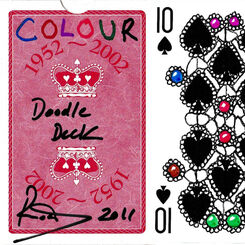
Colour doodle deck
“1952-2002 commemorative deck” customised with doodles by an uncredited artist, UK, 2011.
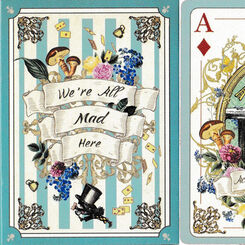
Alice in Wonderland: we’re all mad here
Alice in Wonderland themed playing cards, UK, 2020.
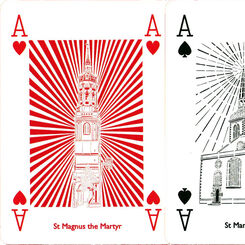
Wren 300 playing cards
Papercuts by Chloe Campbell of the 52 Wren churches in the City of London.
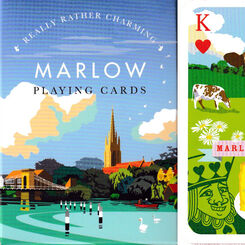
Marlow playing cards
Visitor attractions and businesses to be found in Marlow, Buckinghamshire.
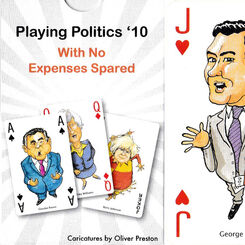
Playing Politics 2010
“Playing Politics ’10: With no expenses spared” featuring caricatures by Oliver Preston, published b...
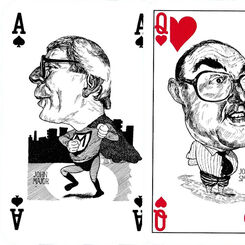
Playing Politics ’92: Pack of lies
Playing Politics ’92: Pack of lies with caricatures by Grant Robertson, UK.
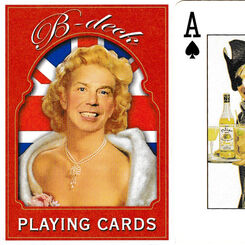
B-Deck
“B-Deck” scurrilous playing cards poking fun at a former UK prime minister.
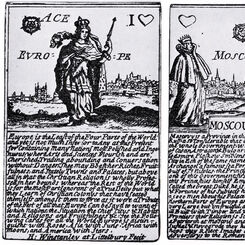
Winstanley Geographical cards
Facsimile of Winstanley’s Geographical cards produced by Harold & Virginia Wayland, 1967.
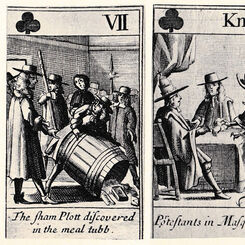
Meal Tub Plot
Meal Tub Plot playing cards [facsimile] with 17th century sketches by Francis Barlow.
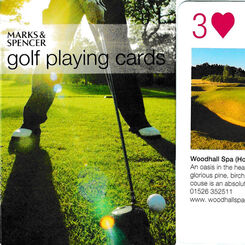
Golf playing cards
Golf playing cards published by Marks & Spencer, UK.
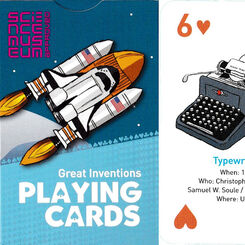
Great inventions playing cards
Great inventions playing cards designed by Gary Wyatt, United Kingdom, 2011.
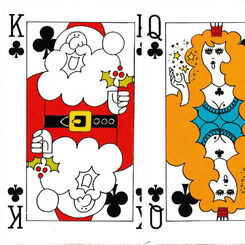
Christmas 1980 playing cards
Festive courts on a Waddingtons pack designed to celebrate Christmas 1980.
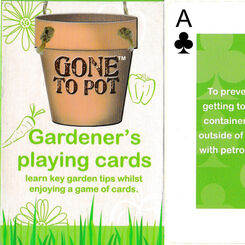
Gone to Pot: Gardener’s playing cards
‘Gone to Pot’: special playing cards for keen gardeners, United Kingdom.
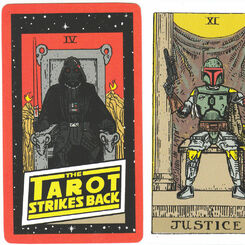
The Tarot Strikes Back
Roy Huteson Stewart's The Tarot Strikes Back combines Star Wars with Rider-Waite tarot imagery.


